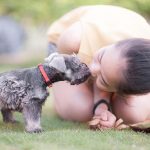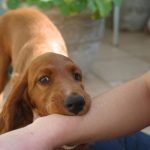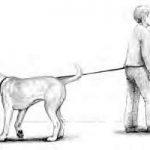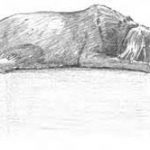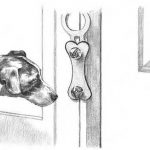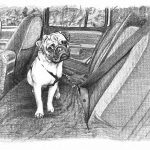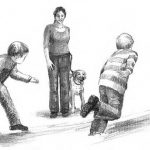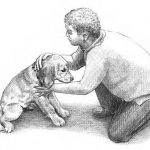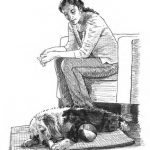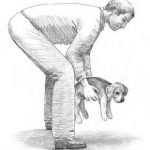Teaching Everyday Etiquette
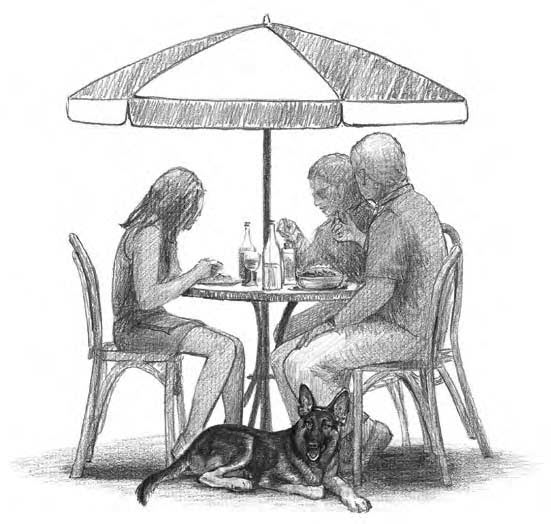
In This Chapter
- Getting your puppy ready for full freedom
- Adjusting your pup to your comings and goings
- Dealing with car travel
- Bringing your puppy out in public
- Training your pup to meet and greet gracefully
A well-behaved puppy is a welcome social guest, a plus at parades and picnics, and an added fan at after-school sporting events. Unfortunately, your puppy won’t train herself to be well-mannered and well-behaved, and she’ll be influenced (positively and negatively) by everyone who surrounds her.
Civilizing Your Pup Room by Room
Remember
Though the first days of etiquette training involve keeping your puppy secured to a leash, think of it less as controlling and more as holding your puppy by the paw. These techniques will teach her how to contain her impulses and gently ease her into household freedom.
Leading
Remember
The sooner you introduce your puppy to your home, the faster she’ll mature. Like children, puppies adapt to new experiences more thoroughly when they’re young.
1. Make sure you’re using the right training collar.
Tip
If you don’t know what collar is the right one for your pooch, consider your options by asking your veterinarian, checking out Chapter Home Sweet Home, or visiting me online at www.dogperfect.com. Until your puppy is 16 weeks, use a regular buckle collar, head collar, or no-pull harness.
2. Hold the leash or secure it to your waist like a belt.
Put the clip/knot of the secured leash to your left hip if you want your puppy on the left or on your right side if you want her on the right. Just make sure you tell your friends and family which side you clip your pup to because she can become confused without that consistency.
3. To teach your puppy proper leash manners, and to prevent pulling, take her to a hallway or cleared room. Walk straight ahead.
4. The moment she walks ahead of you, call out her name and turn in the other direction.
Praise her, even if you feel a tug.
5. Continue to turn away from her until she pays attention to her name and stops trying to race ahead.
Now you’re walking in style. Your puppy will follow wherever you lead her. This is your big chance: All household decisions are up to you. Having your puppy attached to you may seem awkward at first, but soon you won’t even know she’s there. You may even consider it fun. Remember, you’re teaching your puppy to follow you, so if there’s a conflict of interest (she wants to go left when you’re going right), always go your way and encourage her to follow.
Warning!
Some dogs love to walk their owners. They find it enormously fun to drag you down the street because it reminds them of all those tug-of-war games you play together. The first step in correcting this problem is eliminating those tug-of-war games. Also, when your dog takes the leash in her mouth, sharply tug it back into the roof of her mouth (not out of her mouth) and ignore her. Focus and praise her when she’s cooperating.
Remember
6. As you lead your puppy around, start using your foundation directions (see the upcoming section “Teaching basic commands while leading”). Encourage everyone around your puppy to use the directions, too.
Remember
When giving directions, speak clearly, give your directions once, and enunciate your syllables because puppies understand sounds, not words.
Tip
Everyone who’s able to lead the puppy around should do so. You don’t want your hierarchy to become a dictatorship. The only unacceptable combination is small children and big puppies. Other than that, everyone in the household should take part. If the lead is too long for a child, he can use a short leash or wear it like a banner across his chest.
Teaching basic commands while leading
– “<Name>, follow.” Give this direction whenever you start walking or change direction. As you turn, hold your head high and don’t look at your puppy until she turns with you.
If your dog or puppy isn’t leash trained, put some biscuits in a cup, place your dog on lead, and shake the cup as you walk around, encouraging her to follow by saying “<Name>, follow!” Then pick up the lead and walk around with the cup. Stop every 10 feet or so and give the dog a treat.
– “Sit.” Use this direction whenever you offer your dog something positive such as food, praise, a toy, or a pat. Say the direction only once, helping her into position if she doesn’t respond. You should say “Sit” only once because puppies understand sounds, not words, which means that “Sit-Sit-Sit” sounds much different from “Sit.”
Saying please (sort of)No, you can’t teach your puppy to literally say please, but she can gesture when she wants something. If you consistently direct your puppy to “Sit” before offering her anything she perceives as positive, she’ll sit when she wants something, just as readily as most dogs jump. Here are some situations where you want your puppy to say please:
If your puppy doesn’t sit automatically, simply position her by using the technique discussed in the section “Teaching basic commands while leading.” |
Tip
Is your puppy just learning to sit? To position your puppy properly, avoid pushing on her spine. With your right hand, gently lift the chin or pull upward on the collar, as you squeeze her waist gently with your left thumb and forefinger. This pressure point tucks her neatly into place without pressuring the skeletal system.
– “Wait” and “Okay.” This duo is a real prize. Imagine getting your puppy to stop before she races downstairs or across thresholds. Each time you cross a threshold or heavily trafficked area, direct her to “Wait” and bring your dog behind you with her lead. She may get excited, so wait until she settles down before you direct “Okay.” Make sure your feet cross the threshold first. Leaders must always lead.
– “Excuse me.” Use this direction whenever your puppy crosses in front of or behind you. Also use it if your dog presses against you or blocks your path. As you say “Excuse me,” gently knock your puppy out of your way with your foot or knee (hands are perceived as interactive). Remember, puppies respond to hierarchies, so you need to establish yourself as the leader.
– “Settle.” Teaching your dog to lie quietly in a new environment is no easy task. Read the upcoming sections on anchoring and stationing, and soon your dog will quiet down on cue.
Dealing with resistance while leading
– Keep trucking. Don’t turn around. Skip, hop, and praise the air in front of you and walk a little faster: Your puppy will resist initially but will then run to catch up. When she catches up, praise her happily and continue. This method works well with large breeds that have a reputation for being stubborn.
– Kneel forward. If you have a more delicate breed or a puppy with a timid temperament, kneel down in front of your puppy (facing forward) when she puts on the brakes. Tap the floor or shake a cup of treats and encourage her to follow you. When she does, praise her warmly. Then go to the end of the leash again and repeat yourself. She’ll catch on soon enough.
Remember
Don’t give your puppy attention for stubborn stopping, and absolutely never pick her up.
Anchoring
Tip
To discourage these habits while you’re sitting, I suggest that you use a civilized routine called anchoring. Follow these steps:
1. With your puppy secured at your side, slide the end clip around to your tailbone and sit on the remaining slack of the leash.
2. Leave enough room for your dog to lie comfortably behind your feet and offer her a favorite chew toy.
3. Instruct “Settle,” and pet and praise your puppy when she does so.
Stationing
Warning!
Your puppy must be at least 12 weeks old before you begin stationing her. Before then, supervision, crate time, and safe-room freedom are best. When puppies are young, they’re curious and impulsive and . . . clumsy. They can get into situations out of their control. Enclosures (see Chapter Home Sweet Home) mirror the safety of a den.
Remember
Determining how long you can station your puppy depends on her age and mental state. A sleepyhead of any age can handle an hour or more, and an older pup can handle more extended periods. The best gauge is your puppy’s behavior — keep her stationed near you and be aware of her signals. If your pup has been napping at her station for an hour and suddenly gets up and starts acting restless, she probably needs to go to her potty spot. If your puppy chews on a bone for 15 minutes and then starts acting like a jumping bean, she’s probably going through an energy spurt and needs time for a little play.
Warning!
Puppies fidget, so make sure the station is away from stairs, electrical cords and outlets, or other entanglements. Be sure the object you secure your puppy to is immovable, sturdy, and unable to tip. If you have nothing to secure the lead to, screw an eye hook into the wall and clip the leash through it.
Warning!
Some dogs panic when initially stationed. If you’re concerned about your pup, determine whether her reaction is really a panic attack or simply a persuasive protest. You’ll know because panicked dogs don’t focus on you. On the other hand, dogs who protest are very focused on you and usually bark. Ignore the protesting dog. If your pup’s truly panicked, initially station her only when you can sit with her. Encourage bone chewing and begin to leave her side only when she’s sleeping. She’ll soon get the hang of it.
Remember
Bravely ignore whining or barking, unless your puppy’s communicating a need (for example, you’ve missed a feeding or outing or playtime). If she barks and you soothe her, you’re teaching a lesson with headache written all over it. Along the same lines, only release your dog from a station when she’s calm and quiet. Otherwise, you risk reinforcing a negative behavior. If she gets out of hand, you can try distracting your puppy by using a fancy long-distance squirt gun. But you must be very discreet. You don’t want your pup to know where the water is coming from because the interaction will override the discouragement.
Ding-Dong! Teaching Doorbell Civility
Whoever so runs the doorway, rules the denAt the end of the day, your puppy is still a dog. She may be domesticated, but she still views the world from a wolf’s perspective, adjusting to your home as though it were a den. Your doorway is the main thoroughfare to the den and whoever rules it, runs the show. So, with that image in mind, set the structure. Direct your puppy to “Wait” before entering and exiting as if to say “Please let me make sure the coast is clear.” Aside from instilling civility in your pup, you’re acting like a leader — and your puppy will know it. After she obeys the “Wait” command, either proceed in front of her or release her into an enclosed yard. |
– Secure a greeting station. Designate an area by the door to send your pup to when company arrives. Secure a leash to the area and place a favorite chew or toy there. Practice the setups described in the next bullet and secure your pup to the area when the bell rings.
Remember
House rules: Everyone must ignore your puppy until she’s calm — even if it takes an hour.
– Practice doorbell setups. Put your dog on a training collar (if age appropriate) and a leash. Position someone at the door and ask him to ring the doorbell ten times at 20-second intervals; tell the visitor that you’ll answer the door on the tenth ring. Between the first and tenth rings lead your puppy around as if nothing is happening. Then lead your puppy to her greeting station when you answer the door. Practice these setups twice a day until your dog tones down her reaction.
Tip
If your dog is a real maniac, try the head collar (described in Chapter Home Sweet Home) or discreetly spray a deterrent in front of her nose as you say “Shhh.”
– Do the reverse yo-yo. Secure a 4-foot lead to your puppy’s nylon collar. Tie a knot in the lead 4 inches past where the lead passes your dog’s toe. Before you open the door, step on the knot. Your puppy will still jump, but this rig forces her down. Encourage your company to give the dog attention only when she’s calm.
– Designate a greeting toy. If your dog’s a real tennis-ball fanatic (or really loves any other toy), withhold that toy from her until you have company arriving. Each time you enter your home or company arrives, wait until your puppy has calmed down, and then after she has, give her the toy and say “Toy.” Eventually, she’ll get the toy the moment she notes an arrival.
Teaching Your Pup to Take Departures and Arrivals in Stride
Remember
When your puppy is isolated, she’s likely to suffer isolation anxiety. However, it’s nothing to lose sleep over: Kids feel it too as part of life’s grand adjustment. Your pup will get over it as long as you remain calm and treat her consistently each time you leave and return. Here’s my system for teaching your puppy to deal with your leaving and returning home — use it whether you’re leaving your puppy in a gated space or in her crate.
Leaving: No drama, please
Tip
If you find that getting out your keys or your coat trigger her anxiety, frequently stage a departure, but stay home and play with your pup instead. Soon the sound of the keys will carry other meanings too, and anxiety won’t be the only thing on her mind. When you actually leave, reserve a favorite bone that will engage her as you walk out the door calmly.
Coming back: Keep it cool
Remember
If your puppy gets excited upon your return, just ignore her. If she’s behind a gate (inside or out), she’s likely to be leaning on it or clawing at it. Don’t look at, talk to, or touch her. Yes, she’ll be utterly confused — especially if you’ve conditioned this behavior by immediately releasing her. But the tides will turn quickly: within days to weeks. When your puppy calms down to a reasonable level, release her, but remain calm and level-headed. Any show of excitement on your part will send her into a tizzy. Kneel down by your pup, caress her, or toss her a toy. If you reunite with her like you want to be greeted waking up from a nap, you’ll have a dog whom anyone could come home to!
Dogs around Your Dinner Plate
Tip
For your own mealtimes, designate a station area 4 to 6 feet from the table for your puppy to sit or play at while you and your family are eating. If you’ve already encouraged interruptions, you can be sure she won’t stay put initially. So, station her there, as described earlier in this chapter. If she’s still having trouble relaxing, exercise and play with her just before you eat, and set aside a special chewy or toy that only comes out when human meals are being served.
Remember
Looking at your puppy invites her to the feast. To encourage civility, ignore her while you eat. I know it seems cold-hearted, but in the end you’re teaching her that this is the time to snooze or catch up on some undisturbed chewing.
Achieving Calm and Happy Car Rides
Remember
Negative corrections don’t work to shape good car manners. Yelling is perceived as barking — as backup, collaboration style. Besides, discipline and driving just don’t mix — someone has to keep one eye on the road. To stop wild puppy antics in the car or to train a pup to behave, you need to follow some simple routines.
Getting your pup into the car
1. Lead your puppy to the car using the direction “Heel” or “Follow.”
2. Open the car door and direct “Wait,” and then pause.
3. Say “Settle” and direct your puppy to a prepared car station or into a crate.
A car station is like any other station in your home. Identify it with a mat and toys and attach a leash to a collar or harness to prevent pacing and fidgeting while you drive.
4. Secure your puppy (see Chapter Living with Your Puppy in the Real World for options), show her a toy, and tell her “Stay.”
Now you can proceed to your destination. Things always go more smoothly when they’re organized.
Remember
If your dog barks in the car, restricting her motion will lessen the tension and create a far more subdued ride. Consider a head collar too (Chapter Home Sweet Home) — by the nature of the position it reminds your puppy that someone else is in charge.
Tip
Does your dog refuse to hop into the car? If she’s a tiny tot, her reluctance is understandable. If, on the other hand, you have a 120-pound Great Dane, you’re the one being taken for a ride. You have to take a stand and make sure you never lift her into the car again. If you do, you’re forcing her into a state of learned helplessness. Lead her to the car, taking some of her favorite treats along — dog or human — and try baiting her in. If treats make little impression, get in the car and, as you bribe her, pull her gently forward. Still no luck? Bring a friend along, pass the lead to him through the car, and have him gently pull as you encourage her forward. If she still resists, physically walk each limb into the automobile one at a time, but under no circumstances should you lift her.
Getting your pup out of the car
1. Before opening the door to let her out, instruct “Wait.”
2. If she jumps forward, catch the car lead, say “No,” and tug her back.
3. Reinstruct “Wait,” and pause until she’s calm.
4. Secure her to a leash and say “Okay” as you let her exit.
5. Instruct “Heel” or “Follow” while bringing her to your side, and then proceed with your adventure.
Dealing with carsickness and fear
Remember
Cars really frighten some dogs. The cause usually goes back to being transported at an early age, but this fear can result later in life, too. If your puppy is afraid of the car, avoid pacifying her or being overly forceful. Both reactions reinforce fear. If you must take her somewhere, pick her up, if possible, or take her to the car while she’s napping. Speak or sing softly while you put her in the car. Have the car ready and have classical music playing on the radio. Equip her area with a familiar blanket and a favorite toy.
1. Designate and prepare a place for your puppy in the back seat or cargo area.
Using a crate is useful if your dog is anxious about car travel (a plastic kennel is best) and if your car is large enough. Always pad the crate for comfort and to prevent slipping.
2. Pull your car out into the open and, with all the doors open, use the car as a playground.
Climb in and out of the car with your puppy while encouraging her interest with favorite toys and treats.
3. After a romp, take a break in the car, giving your puppy water and food if it’s mealtime.
4. Play the “Find the Car” game with your puppy.
Tell your puppy to “Find the Car” while you run over to the car. Treat your puppy for following you. Work this routine until the car is something the puppy enjoys being around.
5. With the engine running, repeat the preceding steps.
6. After a playtime, secure your puppy (in a crate or on leash) to her area and go for a short spin in and out of the driveway.
Repeat this step until your puppy is comfortable with the situation.
7. Slowly extend your trips and consider stopping for a cheerful game of toss or a walk along the way to encourage your dog to look forward to your jaunts in the car.
Warning!
If you must take your puppy on an extended trip, don’t feed or water her much for at least two hours before the trip to avoid either a full belly or bladder. Exercise her before you leave and spread sheets over her area. You can pray that she doesn’t have an accident, but I’d bring paper towels just in case.
Hitting the Streets: Working on Your Puppy’s Public Image
– Keep the leash on. Your puppy’s leash gives you the ability to direct her calmly. Don’t take your puppy off her leash in public for any reason. There are too many dangers.
– Use lots of encouragement. Cheerfulness is contagious.
– Always keep her paws behind your heels. Remember, you lead and she follows.
– Keep the communication flowing. Direction provides your pup structure and security.
– No elimination in public. Take care of eliminating at home. (But bring a bag just in case of accidents.)
– Know when to say “No.” You’ll say “No” to both your puppy and other people.
Tip
Before you hit the streets for real, you want to practice in selected areas so that you can devote all your attention to your puppy. Eventually, being in public will seem effortless, and you’ll both be welcomed everywhere. However, your first trip out may be a real shocker. Are you wondering “If going out in public is such a nightmare, why bother?” Here are three reasons why you should train your pup for going out in public:
– It gets easier.
– A well-mannered dog is fun to share.
– Being out enhances your puppy’s focus. You’ll be the one looking confident in new, unexplored territories.
Remember
When you get to your destination, the first five minutes is three-fourths of the battle. Whatever practice location you’ve picked — a park, a town, a friend’s house, or a building — first impressions really count. If you take control immediately and give understandable directions, the rest is a tail wag.
Controlling the wild one
– Direct her to your heel (using the direction “Heel” or “Follow”). Keep her paws behind your ankles.
Warning!
– Tell strangers to back off until your puppy’s trained. It’s embarrassing, I know, but you have to. You don’t want your puppy jumping up and giving someone a scratch, even if it’s only by accident.
The first-outing bluesThe first outing with your new puppy may be utter chaos, but don’t be discouraged. Even I had the “first-outing blues” with my pup, Whoopsie. She was a headstrong, lively, and playful puppy that couldn’t hold herself back. To make matters worse, she had no leash sensitivity, which meant that no matter how hard I pulled, she just pulled back. She pulled me through puddles, over a bench, and through someone’s flower bed — all par for the course. When people gathered to pet her or another dog was near, she forgot about me completely. But that first outing has passed and Whoopsie has learned that her manners are expected everywhere, whether greeting Aunt Carolyn at the door or ten school children in the park. The eventual compliments on Whoopsie’s good behavior overshadowed my initial embarrassment, but I didn’t start out with perfection, and you probably won’t either. |
– Reinforce your requests. If you ask for a “Sit-Stay,” get a “Sit-Stay.” Keep repositioning your puppy, holding her still by bracing her (I explain this later in this chapter).
– Don’t expect too much. Your puppy may have trouble focusing, so position her when she doesn’t listen (no matter how well you’re doing at home).
Empowering the scaredy-cat
– Look confident and stand tall like a good leader puppy. Soon she’ll mimic you when encountering new situations.
– Bring some treats and a favorite toy — something she can focus her attention on. Withholding these items at home makes the new adventure seem really exciting.
– Use the “Heel” and “Stay” directions often. Familiar sounds soothe anxiety.
Tip
If she’s too nervous to listen, enforce a response by positioning her physically without corrections.
– Keep the situation calm and positive. Deflect any admirers until she’s feeling safe.
Under and back: Helpful commands when you’re out and about
Remember
Your puppy really wants you to be her guardian and protector. Whether resting at home, with company, or in town at a cafe, your pup feels most secure when tucked safely under your legs (see Figure 13-1).
1. Sit on the edge of a chair with your legs bent out in front of you.
2. Wave a treat to bait your puppy.
3. Lead her under your legs.
Tip
If necessary, use pressure points to encourage her into the “Down” position (see the section “Civilizing Your Pup Room by Room,” earlier in this chapter).
4. Direct her to “Stay” if she’s familiar with that direction, and give her a bone to chew or toy to play with. If your puppy is young or hasn’t learned “Stay,” gently guide her into position and distract her with a bone or toy.
Remember
Another direction, “Back,” teaches your puppy to back up and get behind your feet. This direction is ideal for outings and social greeting where her enthusiasm may override her focus. To bait her with a treat, draw it back directly under her chin and press her chest gently as you guide her body behind you. If she sits or lies down, hold her waist up by tucking the flat of your palm under her belly.
Making Friends: Introducing Your Pup to Other Dogs
Gaining control when encountering other dogs
Warning!
If you see a dog when you’re out and about, don’t approach him immediately. First, gain control of your situation by following these steps:
1. If your puppy acts excited, bring her “Back” and remind her to “Heel,” if these directions are familiar. Otherwise, tug her back to your side, use “Let’s Go,” and proceed with the steps as outlined.
2. Continue in your original direction and pick up your pace.
Your goal is to leave the area in case the dog perceives you as trespassing on his territory.
3. Don’t look toward, approach, or follow the other dog. Your excitement may be misconstrued. Unless you know the other dog well, don’t approach him.
4. If your puppy continues acting wildly, speed up and keep tugging the leash.
5. Praise her for focusing on you instead of the dog.
6. Never give in or let up.
You don’t want to raise your puppy to race away from you each time she sees a potential friend.
What if the training tables are turned?Suppose that you and your puppy are out taking a walk and you’re approached by someone who’s out teaching her puppy socialization skills and wants to have her puppy greet yours as a training exercise. Are you obligated to get involved? No. If you’re not in the mood, or your puppy’s too hyped, just say no. If you’re game, however, get your puppy in control behind you and then release with “Okay, go play!” Call her back to “Heel” when playtime is over. |
Go! Giving your pup the green light
Warning!
If you’re approached by an off-lead dog, don’t hesitate, don’t look at the dog, and don’t let your puppy look at the dog. Just walk quickly away from the area. Discourage any confrontational attempts your puppy makes. Both of you should avoid eye contact. An off-lead dog defends his territory. However, if you leave without confrontation, he’ll stop the chase immediately to harbor his fighting reserves for a more threatening foe.
Introducing Your Pup to People
Remember
Before you venture into the social scene, though, read over the following disclosures. If you identify with any of them, follow my specific instructions and skip the rest of this section:
– First disclosure. If you’re having aggression problems, the only person you should introduce your puppy to for now is a trainer or behaviorist with a specialty in aggression rehabilitation. How do you find such an expert? Ask your veterinarian. It’s better to be safe than sued.
– Second disclosure. If you notice your puppy getting nervous or tense around unfamiliar people, join a class or work under private supervision. Don’t push the issue alone.
– Third disclosure. If you don’t believe that you have what it takes to train your puppy, you won’t. Confidence is contagious, but so is a lack of it. Hire some extra help if you need the support.
Following five key rules
– Rule #1. Make sure your puppy is familiar and comfortable with the setting before you attempt to introduce her to anyone. Don’t greet people your first day out.
– Rule #2. Human feet should always be ahead of doggie paws. Gently tug her back if she forgets, realigning her if she attempts to scoot forward.
– Rule #3. Tell admirers “We’re in training,” so they respect your efforts and contain their own excitement (hopefully).
– Rule #4. Stay more focused on your puppy than the admirer. Tug your puppy back into position if she attempts to break or brace her as described in the next section.
– Rule #5. Put faith in your own knowledge. Just because everyone has advice doesn’t mean they’re right. “I don’t mind if she jumps” doesn’t hold water. You mind if she jumps, so don’t give in.
Introducing the wild one
Tip
Ask people to wait until your wild one is calm before they approach. Enforce a “Sit-Stay,” keeping your feet ahead of her paws. Brace her by placing your left hand, fingers down, along her waist and below the ribs and your right thumb clipped over her collar (facing down). Hold her steady in case she jumps. If the person still wants to, he can pet your puppy. Remind your puppy to “Stay,” and don’t let up your vigil until the person is gone. Whew! What a workout.
Introducing the scaredy-cat
Tip
If your puppy is a little cautious when people approach, before you start out, place some treats in your pocket (or, if your puppy likes peanut butter, bring along a tube of it) that an admirer can extend to her.
Entering Buildings Peacefully
1. Bring your puppy to your heel as you exit the car.
If she’s familiar with the direction, say her name and “Heel.” Say “Shhh” if she starts getting excited.
2. Pause before you open the door and direct “Wait.”
Don’t open the door until she’s settled down.
3. If your puppy lurches forward, tug her back and say “Back.”
Pause again until your puppy is calm.
How to impress your vetI’ll let you in on a secret: Veterinarians love a well-behaved dog. It makes their job a lot easier. To impress your vet do the following:
Some puppies aren’t wild about receptionists and aren’t too impressed by the veterinarian either. Set up a practice run and ask the receptionist to meet you outside. Give her your puppy’s treat cup (see Chapter Using Cool Tools and Groovy Gadgets), and ask her to avoid making eye contact with your puppy. If your puppy is tense, avoid confrontation. If your puppy wants to approach, have the receptionist reward her with treats. |
4. Say “Okay” as you lead her through the door.
5. After you’re inside, direct your puppy under your legs or onto a mat positioned at your side.
Give her a bone if you expect her to stay put.
Tip
Some dogs are nervous when they enter new buildings. If your puppy is, don’t reinforce her anxiety. If your puppy’s showing fear, you need to show confidence. Don’t pet her or reassure her that things will be okay. Instead, take along some treats to encourage her to follow you as you approach the building. If she puts on the brakes, kneel down (don’t run back), and encourage her inside with food and gentle tugs.
Sarah Hodgson




